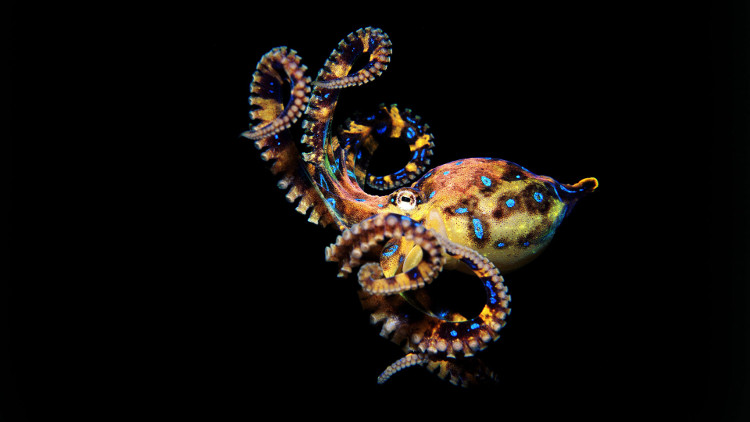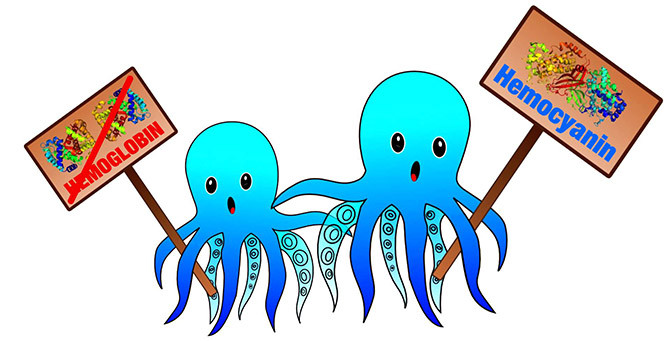Why is octopus blood green?
Octopus is a surprisingly complex creature with 500 million neurons on its head and body, capable of planning, deducing and predicting motion.
According to Howstuffworks, the researchers found that the octopus in Indonesia will gather coconut shells to prepare for stormy weather, then find shelter by getting inside the shells and closing them. .

Octopus is a very intelligent animal.
If you ask Jean Boal, a Millersville behavioral researcher about the inner life of octopus, she can tell you that they are a communicative and cognitive creature. Boal has an octopus in the lab, once she uses a dry squid as food for her and the octopus uses one of the tentacles to push the squid away, implying that it will never eat old food.
So what makes these smart marine creatures so amazingly adaptable? The answer may be in their blood.Hemocyanin - the pigment that makes octopus blood green , is responsible for keeping them in harsh environments with extremely high or extremely low temperatures. Hemocyanin is a blood protein that contains two copper atoms (Cu) inversely linked to a single oxygen molecule (O 2 ). Oxidation changes color from Cu (I) to color without receiving the green oxygen to Cu (II) when receiving oxygen. It is part of plasma in invertebrates.

Hemocyanin is a pigment that makes octopus blood green.
The blue pigment hemocyanin binds closely to oxygen in the blood and transports throughout the octopus's body to provide tissue, an important factor for survival. Octopus has three hearts and needs more oxygen than most other invertebrates, so hemocyanin helps octopus get a stable supply of oxygen, even if it is not available in the white environment. octopus Hemocyanin also ensures survival for octopus at temperatures that can kill many other organisms, from 28 degrees Fahrenheit (minus 1.8 degrees Celsius) to super-hot temperatures near the sea floor vents.
In contrast, mammalian blood (including us) is red because it contains hemoglobin rich in iron elements.
- The octopus squadron 'raided' the beach surprised many people
- Discovered animals with strange blue blood
- Octopus is more poisonous than cobras that wash up on the coast
- Octopus - one of the smart species does not use the brain
- Close-up of blue-spotted octopus has 50 times more venom than cobra
- Detecting octopus 'super small' at sea
- The genius of the ocean? Please call the octopus name!
- Training octopus into the world's first photographer
- Video: Found strange octopus near Hawaii
- The little-known dark secret of the octopus has now been discovered by science
- Scientists absolutely warn against raising octopus
- The video of the octopus escapes the egg bag causing fever in the online community
 Surprised: Fish that live in the dark ocean still see colors
Surprised: Fish that live in the dark ocean still see colors Japan suddenly caught the creature that caused the earthquake in the legend
Japan suddenly caught the creature that caused the earthquake in the legend A series of gray whale carcasses washed ashore on California's coast
A series of gray whale carcasses washed ashore on California's coast Compare the size of shark species in the world
Compare the size of shark species in the world Four new species appear as 'hybrids' of extraterrestrial creatures
Four new species appear as 'hybrids' of extraterrestrial creatures  First time filming the moment an octopus shoots rocks at predatory fish
First time filming the moment an octopus shoots rocks at predatory fish  Octopus jumps on the seabed 4,800m deep
Octopus jumps on the seabed 4,800m deep  The octopus sacrifices its arm to escape the eel
The octopus sacrifices its arm to escape the eel  Diver gets scared when being led by an octopus to a tombstone on the seabed
Diver gets scared when being led by an octopus to a tombstone on the seabed  Why do octopuses eat eggs and gnaw their hands?
Why do octopuses eat eggs and gnaw their hands? 